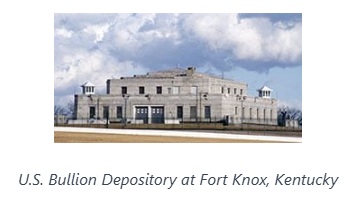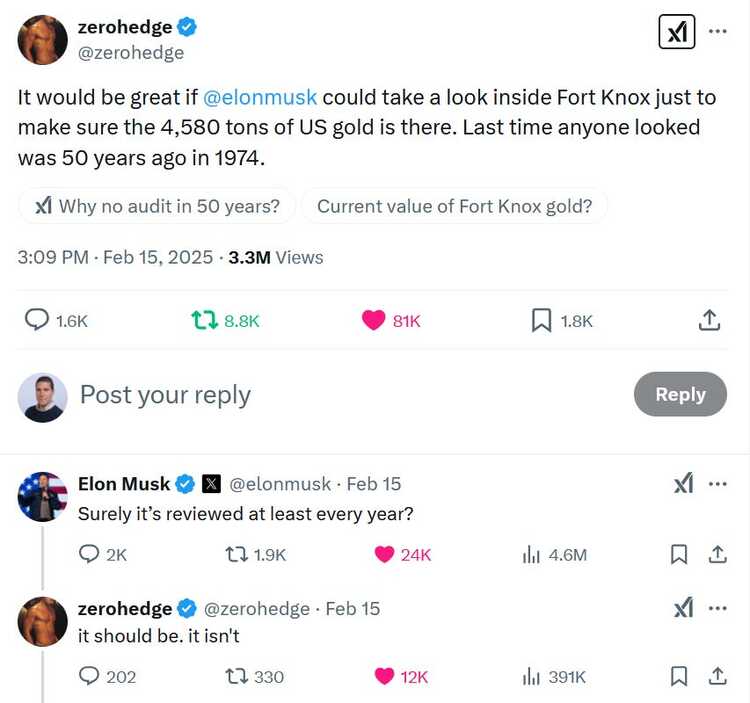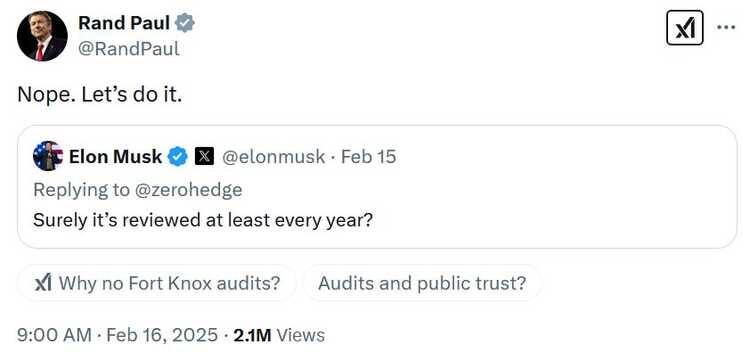What You Need to Know About a Possible U.S. Gold Revaluation
Since 1973, America’s gold has been officially valued at just $42 per troy ounce—but that may soon change.
When Donald Trump won the U.S. presidential election on November 5th, gold and silver immediately plummeted—down 9% and 15%, respectively—as many investors soured on precious metals. They believed a Trump presidency and the promise of "Making America Great Again" signaled an era of prosperity, stability, and fiscal prudence, eliminating the need for crisis hedges like gold and silver.
Of course, I had been adamant that his victory was no reason to turn bearish on precious metals. I even pointed to his first term, during which gold soared an impressive 83%.
Following this mindset, they eagerly poured into the riskiest assets, chasing overinflated tech stocks and speculative cryptocurrencies like Bitcoin, Dogecoin, and even Fartcoin—a reckless move.
Yet, how wrong they were! Gold not only erased its election-related losses but has surged to a new record—now roughly $100 above its pre-election high in late October—while silver is close behind.
Gold and silver have surged since Trump took office for several key reasons, many of which I’ve covered extensively. These include the potential impact of tariffs on imported precious metals and a massive inflow of gold and silver into the U.S. ahead of those tariffs, which is draining London’s vaults. Additionally, soaring inflation expectations and mounting fears of a recession alongside persistent inflation have fueled concerns about stagflation—a scenario historically very bullish for precious metals.
I'm not going to lie—it’s a highly confusing and chaotic time, with countless crosscurrents and major developments as Trump rolls out his policies and reshapes the government.
Another potential reason for gold’s surge is emerging: the very real possibility that the Trump administration could revalue America’s gold—a move that aligns with its goal to "Make America Great Again."
The U.S. federal government officially holds 8,133 metric tons of gold. What’s striking, however, is that since 1973, it has remained valued on the books at just $42 per troy ounce, giving it a paper worth of only about $11 billion.
If the official reserve figure is accurate, the U.S. holds the world’s largest gold stockpile by a wide margin, with Germany trailing in second place at 3,352 metric tons.
But here’s the thing: with gold now trading at $2,900 per ounce, revaluing America’s gold reserves to market prices would push its worth to approximately $760 billion—creating a staggering $749 billion windfall. This aligns with the February 3rd remarks by newly appointed Treasury Secretary Scott Bessent, who is known for his pro-gold stance and personal investments in the metal.
He stated that the government would "monetize the asset side of the U.S. balance sheet," which essentially means revaluing the country’s gold reserves at a higher price.
This could allow the government to either sell some of its gold holdings or simply strengthen its financial position by increasing assets relative to debt, thereby reducing leverage.
I must emphasize that while revaluing America’s gold would benefit the country and makes perfect sense, the resulting $749 billion windfall would barely make a dent in our fiscal challenges.
With the national debt now at $36.49 trillion—growing by roughly $1 trillion every 100 days—and unfunded obligations reaching approximately $73.2 trillion, this measure alone would be a mere drop in the bucket.
In addition, since the 2020 pandemic, America’s surging national debt, combined with rising interest rates, has more than doubled annual interest payments to over $1.1 trillion.
In 2024, gross interest on U.S. debt exceeded spending on defense, income security, health, veterans’ benefits, and even Medicare—making it the second-largest expense for the U.S. government, trailing only Social Security.
One theory gaining traction is that the U.S. could revalue its gold reserves to partially fund a sovereign wealth fund, which would include a stockpile of digital assets.
This idea has been championed by Wyoming Senator Cynthia Lummis, along with outspoken Bitcoin advocate and billionaire Michael Saylor. However, recent comments suggest that Bitcoin may play a smaller role in this digital asset portfolio than initially expected.
Instead, U.S.-founded digital assets like Solana, USDC, and Ripple’s XRP are likely to take center stage—a shift that has frustrated Bitcoin-only advocates.
I am personally horrified by—and strongly caution against—the prospect of selling America’s gold, an asset that has served as a reliable store of wealth for 6,000 years, in favor of cryptocurrencies.
Furthermore, cryptos have never caught on as actual currencies used for making real-world purchases as originally intended; instead, I see them as flimsy digital tokens propped up by the “greater fool theory” to justify their price.
Even the most established cryptocurrency—Bitcoin—has existed for only sixteen years, meaning it has yet to stand the test of time. America should not be allocating its resources to something so unproven.
Moreover, anyone can create a crypto token, leading to an ever-expanding supply. This makes them inherently cheap and flimsy compared to gold, which is truly scarce.
Moving along, if America is to revalue its gold, it’s crucial to first verify that it actually exists—something that isn’t necessarily a given. For decades, speculation has swirled over whether the U.S. Bullion Depository, commonly known as Fort Knox, along with other government vaults, truly holds the gold the government claims.
One of the last so-called "audits" of America’s gold reserves took place on September 23, 1974, when the U.S. Treasury briefly opened just one of Fort Knox’s 15 vaults, allowing politicians and reporters a two-hour photo-op with roughly 6% of the alleged holdings.
 For years, the precious metals community has called for an audit of U.S. gold reserves, only to be dismissed, ridiculed, and labeled as conspiracy theorists for merely questioning whether the gold exists in the quantities claimed.
For years, the precious metals community has called for an audit of U.S. gold reserves, only to be dismissed, ridiculed, and labeled as conspiracy theorists for merely questioning whether the gold exists in the quantities claimed.
However, with the Trump administration in the White House and the Department of Government Efficiency (DOGE), led by Elon Musk, uncovering rampant waste and fraud in government spending, the Overton Window has swung wide open for a long-overdue audit of America’s gold reserves.
The push for an imminent audit of Fort Knox gained momentum on Saturday when the popular financial blog ZeroHedge—where I have been a long-time and frequent contributor— publicly called on Elon Musk via X to launch an audit and verify whether the U.S. gold reserves are truly there.
I was thrilled to see this unfold and fully supported the effort, reposting the entire exchange to my 174,000 followers. Many others in the community did the same, causing the post to go viral and sparking serious discussions about the need for a full audit.

Shortly after, Senator Rand Paul (R-KY) responded, expressing his support for the audit:

After decades of speculation, the precious metals community—along with concerned citizens and even Elon Musk—is now asking a critical question: What happens if the Fort Knox gold audit takes place and reveals that the reserves are missing or significantly lower than expected?

Then, a fascinating old clip from the 1996 documentary The Money Masters, produced by William T. Still, began circulating on X.
The clip suggested that the gold in Fort Knox had been stolen and made an intriguing claim: Ian Fleming, author of the James Bond series and alleged head of the UK’s MI5 Security Service, was aware of the theft.
According to the theory, Fleming embedded this revelation into his fiction as a warning that Fort Knox had been robbed of its gold.
Just a few hours ago, a new bet was launched on the betting market platform Polymarket, allowing people to wager on whether Fort Knox is indeed missing its gold.
So far, the odds imply only an 18% chance that the gold is gone, but as this saga unfolds, it will be worth watching—especially as we await the audit, assuming it actually takes place.
I'm not a forensic accountant, nor do I enjoy speculating about conspiracy theories that I can't personally verify—and there are many in the gold and silver space. However, I have a deep distrust of the official narratives presented by the government, central banks, and similar institutions. So, if Fort Knox were missing some or all of its gold, I wouldn’t be so shocked. But that’s precisely why audits matter—to eliminate speculation and guesswork.
Regular audits of the U.S. gold reserves should have been conducted all along to dispel conspiracy theories, assuming they weren’t true. The fact that they weren’t raises serious questions.
What I do know for certain is that I fully support an audit of U.S. gold reserves, as it would strengthen fiscal transparency and improve confidence in both the nation's financial integrity and the precious metals market.
*******




















